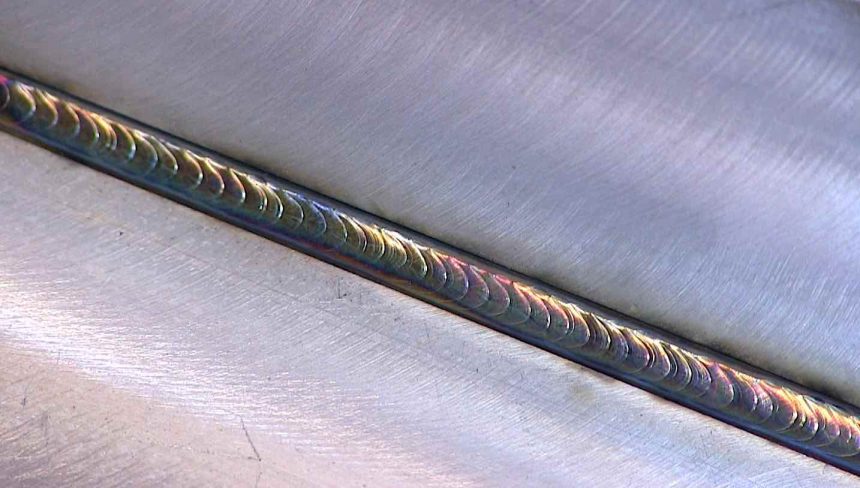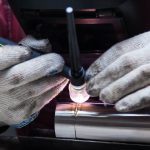In the case of aluminum, stick welding methods don’t serve that well as they create a lot of slag and splatter which is labor intensive to clean up. That’s why you should prefer gas tungsten arc welding also known as tungsten inert gas welding or TIG welding, which employs gas to safeguard your weld rather than flux. It is among the most widely utilized welding methods for aluminum.
Which welding technique is most suitable for aluminum?
Welding Town
TIG welding involves using a steady alternating current (AC) setup and 100 percent argon as a shielding gas. Since no mechanical wire feeding is required in the process, you will reduce your material feed issues.
Instead, the filler material gets fed into a puddle by the welder. Because the AC removes the oxidized coating from the aluminum as it welds, this technique is also exceedingly clean. Additionally, it guards against contamination of the aluminum throughout the procedure.
1. Focus on your hand position
Ideally, you should brace your hand over the surface you’re using with the outside of your hand facing down. You can keep your weld steady by bracing your hand against a tabletop or workbench, improving its appearance and finish. Avoid angling your torch excessively because doing so will result in an inconsistent, large pool that will be difficult to manage.
Additionally, you could also overheat the metal in some spots. Maintain it practically straight instead, with just a tiny bit of an inclination rearward to let you view where you’re heading.
Another thing to keep in mind while TIG welding is keeping your hands separated. They will be functioning independently while using the TIG welding technique. The filler rod must be supplied with one hand while the other must be free to move the welder seamlessly.
2. Maintain a consistent distance
Practice maintaining a consistent distance between the workpiece and tungsten for excellent-quality welding. The metal will overheat and become tarnished if you approach it too closely, jeopardizing your weld. This is a crucial consideration for any welding technique but extremely vital while dealing with aluminum.
Always remember that the distance between the workpiece and the welder may vary depending on the project.
Moreover, any breaking of the arc should be averted at all costs. It occurs when you are too distant from the workpiece, allowing the electricity to arc out and become evident and intense, resulting in the workpiece overheating.
3. Be considerate of the temperature characteristics
The aluminum workpiece you will be welding can be thinner than typical steel or other metals. Aluminum has a high thermal conductivity.
Hence you run the risk of unintentional burns due to the metal’s ability to retain heat. You can prevent this by waiting until your weld has cooled before switching back over any of it, or if you must, be cognizant of how hot it is becoming.
Also, your workpiece could sustain damage from the heat that the welder generates as its energy passes through aluminum sheets. Thus, you should take periodic pauses to prevent this situation so that you aren’t constantly recharging the particles around the weld.
4. Be mindful of the conductivity of aluminum
The TIG welding operation can melt aluminum more quickly than other metals because of the high electrical conductivity property of aluminum. The welding equipment has a current control feature that regulates the amount of electricity the instrument sends into the metal.
These are incredibly beneficial for TIG welding, especially on aluminum, as they let you control the power supply so that the material that you are welding does not overheat.
You must be more cautious while using a TIG welder lacking a current control. As you go nearer to the weld, the current will become stronger, but as you back away, it could also increase and begin to break your consistent arc.
5. Clean the workpiece before welding
Cleaning your workpiece will reduce the number of contaminants that are introduced into your weld. Hence, ensuring a clean metal workpiece before welding is crucial since it governs the weld quality. If not, your weld will contain fragments of many alloys, each of which has a different temperature requirement. It will weaken your weld and leave behind stains, marks, and discolored spots.
Conclusion
Aluminum reacts differently to welding than standard metal components. So, the best advice for beginners would be not to jump into the process with predetermined assumptions.
The ideal way to approach welding aluminum is to weld patiently, wear adequate protective gear designed for equipment, and practice as much as possible, and you’ll have a best-in-class product ready for further processing.











